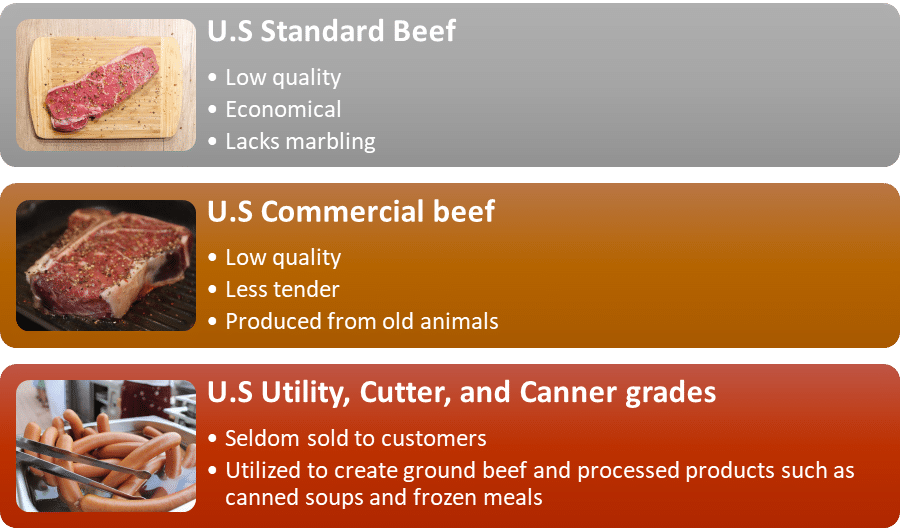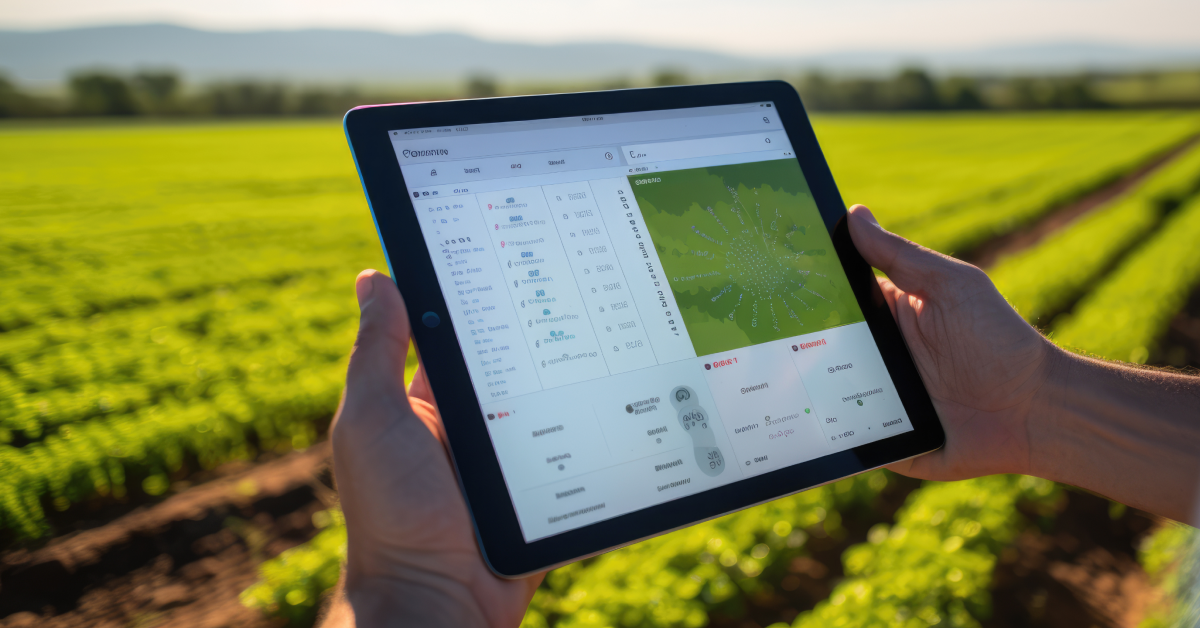What are the grades of meat (beef)?
The purpose of beef grades is to check whether the beef is high quality and safe to consume. The grading system also tells you about the beef’s expected tenderness and marbling.
The USDA has divided beef grades into eight categories that range from the highest quality to the lowest. These grades are USDA Prime, USDA Choice, USDA Select, USDA Standard, USDA Commercial, USDA Utility, USDA Cutter, and USDA Canner.
When you buy beef at a steakhouse, you’ll only encounter these three beef grades Prime, Choice, and Select.
How does Grading of Meat Works?
Cattle producers must pay an amount to have a trained inspector grade their beef. This is how manufacturers can receive a United States Department of Agriculture grading. After the grading, producers are required to follow the guidelines for labelling that are formed by the Food Safety and Inspection Service. Consumers can easily see the USDA grading on the package of meat.
The United States Department of Agriculture has developed a voluntary beef grading system. It is primarily based on the fat marbling level and the maturity of the meat and their respective meat grades. These two factors are responsible for the tenderness of beef. Meat that is obtained from young cattle holds a high grade as it has greater fat marbling.

Source: Clover Meadows Beef
Who grades beef?
Highly skilled USDA graders perform the Process of beef grades. They used subjective and objective methods, including electric instruments, to evaluate meat levels.
What exactly are the USDA grades of meat?
The meat grades given by USDA’s meat grading system are known as a symbol of high-quality, safe, and healthy American beef. Meat quality grades, within the cattle production industry, are used as a language to make business transactions easier. Using this grading system, manufacturers, as well as consumers, enjoy several benefits.
The evaluation is done by highly-trained meat graders of the USDA meat grading system and they use electronic instruments and a subjective characteristic assessment process to do it. All of these characteristics are in accordance with the official grade standards that are developed, interpreted, and maintained by the United States Department of Agriculture’s marketing services.
There are two ways in which beef is graded. Meat quality grades are for juiciness, tenderness, and flavour, and yield grades are for the number of usable meat grades obtained from a carcass.
What components make up the meat USDA grading system?
When grading different grades of meat, the USDA assesses two primary factors:
1)Meat quality grades that measure the beef’s tenderness, juiciness, and flavour.
2) Yield grades that determine the quantity of usable lean meat.
The more well-known aspect among consumers is quality grades since they determine the beef’s tenderness, juiciness, and flavour.
Is All Beef Graded?
In the USA, all beef goes to inspection, but not all undergo grading. Based on beef quality, grading is an optional procedure supervised by the USDA and paid for by beef packer companies.
What are the Eight Grades of beef?
The beef industry has been using eight quality meat grades since 1927. The grades are Prime, Choice, Select, Standard, Commercial, Utility, Cutter, and Canner.
The three quality grades recognized by the consumers are Prime, Choice, and Select. USDA considers these three as food-grade labels.
The USDA Agricultural Marketing Services provides the following definitions for eight grades for consumers and producers.


Picture Source: https://faunafacts.com/cows/us-beef-grades/
Let’s discuss each of these in detail:
-
United States Prime beef
This is the first and highest grade in all beef grades. It has greater fat marbling and this grade’s beef is almost tender. This beef is obtained from young cattle who are very well-fed. This grade’s beef is found in abundance in high-end and posh steak houses, hotels, or restaurants. Around 4 to 5 percent of the total graded cattle are prime cattle. Prime beef is popular for its richness of fat marbling and this is why it is highly suitable for dry-heat methods of cooking such as frying, roasting, broiling, grilling, and baking.
-
United States Choice Beef
65 percent of the total graded cattle make up U.S. Choice Beef. This beef is easily available in restaurants and markets for consumers. It has a moderate level of fat marbling as compared to U.S Prime Beef. 50 per cent of the total graded beef is Choice. Choice beef can be cooked in both moist and dry methods of heat such as roasting, grilling, frying, or even baking. It is an economical alternative to Prime beef.
-
United States Select Beef
This grade of meat is less juicy and tender than the U.S. prime and choice. It has very low-fat content and in order to prevent it from drying, moist heat methods of cooking should be used to cook it such as steaming, braising, poaching, stewing, etc. Out of total graded beef, 25 percent is Select beef and it is easily available in the retail market.
-
United States Standard and United States Commercial Beef
Both grades have less fat marbling and hence they lack tenderness. They are being sold as ungraded beef or, are mostly labelled under the name of the store. They are inexpensive and they require moist heat cooking methods. Mostly they are perfect for recipes that require slow cooking as these both will get dry if fried or grilled.
-
Canner, Cutter, and Utility Grades
These grades of beef are obtained from an older animal and they have no fat marbling. This meat is used for canned products and for meat products that require processing. They are not widely available in the markets but even if you find these grades of meat, you might not want to buy them as they lack tenderness.
Top Quality Grades of Meat by USDA
The USDA has made a total of eight grades and only five grades of them are being made available in the market for consumers. The rest grades are being used in canned products. Specific cuts of beef in different types of cows have different quality grades of meat. Each quality grade has a different use and specific method of cooking. Let’s discuss them shortly:
-
QUALITY GRADE: MARBLING:
The fat that appears as fine white lines in the beef in different types of cows between muscle fibres is called marbling or intramuscular fat. It is distinct from intermuscular fat, which is on the outside and trimmed off.
To determine the beef grade, the USDA examines the amount of marbling in the ribeye muscle between the 12th and 13th ribs, as it influences tenderness and flavour. This grading helps to determine if the entire cow is Prime, Choice, or Select.
-
QUALITY GRADE: MATURITY
The maturity or age of the animal also plays a crucial role in grading beef quality. As cattle age, their meat becomes tougher and leaner, affecting beef tenderness. Therefore, the USDA considers the animal’s age when assigning the Quality Grade. Once maturity and marbling are evaluated, the USDA combines the results to determine the overall quality grade.
-
YIELD GRADE: AMOUNT OF USABLE MEAT:
Apart from beef quality, the USDA also evaluates the yield grade, determining the amount of lean meat in the carcass. This grading aspect is not commonly known among consumers but is well-known among beef processors. The yield grade, which ranges from 1-5, assesses the fat layer covering the meat. For instance, a ribeye with 5/10 inches of fat covering it would receive a yield grade of 1.
What are the problems with the USDA grades of meat?
This system makes it easier to categorize beef but still, there are some flaws that somehow create limitations. The first and significant issue that the USDA grading system has is its narrow criteria for grading meat levels. This system is solely based on the idea that the most important factor that determines the quality of the meat is ‘marbling’. This is an approach that, in the present age, is less accepted.
The USDA grading system does not focus on the number of nutrients present in the meat, the diet of the animal, and the environmental conditions and processes through which the animal is raised. It does not even focus on the animal’s breed.
FAQs
– What are the 3 grades of meat from highest to lowest?
The three grades that rank from highest to lowest are Prime, Choice, and Select.
– What are the 4 quality grades of meat?
According to USDA, Prime, Choice, Select, Standard, or Commercial are the 4 quality grades of meat.
– What are the 5 levels of meat?
The five meat levels are:
- Rare (120 degrees)
- Medium rare (130 degrees)
- Medium (140-145 degrees)
- Medium well (150 degrees)
- Well done (160 degrees)
– What grade is the best meat?
The U.S Prime meat grade is the best one out of the top eight meat grades.
– What is Angus beef grade?
Angus beef grades better frequently on the USDA grading scale however it doesn’t make Angus a grade of quality or that the label Angus on anything you purchase will taste better than any other. Angus beef comes from a cattle breed that is the most popular breed among all cattle breeds.
– What is Utility-grade beef?
Utility-grade beef comes from older cattle that have no fat marbling hence this grade’s meat lacks tenderness and flavor. It is used for canned and processed products.
– Which Grades of Beef are available at Costco?
At Costco, you will find USDA Prime and USDA Choice beef more than other grades of beef. Though USDA Prime is mostly available at high-end restaurants and steakhouses and rarely available in markets, Costco is known for selling Prime beef.
– What does Beef grade A5 stand for?
In ‘A5’, A stands for yield grade and 5 is for a quality grade.






